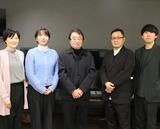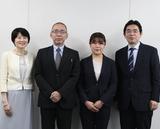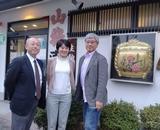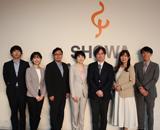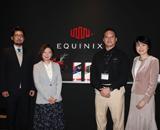August 2020
Surviving in the Age of Uncertainties: The Editor-in-Chief at Diamond Harvard Business Review Discusses the Key to Long-Lasting Magazine Publishing
DIAMOND, Inc. is the publisher of Weekly Diamond (a Japanese business magazine), management-related magazines and books, most famously by Peter Drucker, as well as books such as The Courage to be Disliked and Why We Went Extinct (in Japanese only). The company also publishes the Japanese edition of the world's first management magazine, Harvard Business Review, under the title Diamond Harvard Business Review. This year marks the Japanese magazine's 44th anniversary as it continues to be widely read by corporate executives and young businesspersons throughout Japan. We sat down with Mr. Ryo Otsubo, who is the fourth editor-in-chief that Arc Communications has worked with since becoming the magazine's translation partner. The interview covered a broad range of subjects, such as the work of the editor-in-chief, how best to handle translations for management magazines and the key to long-lasting magazine publishing.
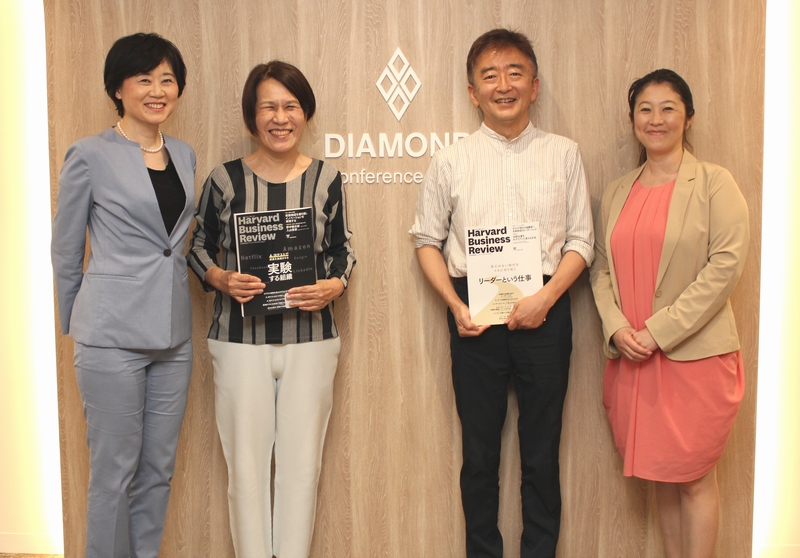
From left to right:
Mariko Ohsato, Akiko Kogure, Ryo Otsubo and Manami Saito
- Profile
- Ryo Otsubo: Editor-in-chief, Diamond Harvard Business Review Editorial Department, DIAMOND, Inc.
- Akiko Kogure: Senior Editor, Diamond Harvard Business Review Editorial Department, DIAMOND, Inc.
- Mariko Ohsato: CEO & President, Arc Communications Inc.
- Manami Saito: Chief Project Manager, Translation & Localization Division, Arc Communications Inc.
An Editor-in-Chief with Democratic Leadership to Encourage Independent Cooperation
Ohsato: To start, could you briefly talk about Harvard Business Review (HBR) and Diamond Harvard Business Review (DHBR)?
Otsubo: HBR was first published as a magazine for Harvard Business School (HBS) and is the oldest management magazine in the world. It collects and edits research discussions, mainly by professors at HBS, on how business management should be carried out. DHBR is the Japanese edition of HBR. It was the first magazine in the world to partner with HBR, and this year marks the 44th year since it was first published.
The magazine's core readers in Japan are corporate executives, managers of major companies, such as department directors and section chiefs, and business school students. Our members in the Editorial Department go through the latest business trends featured in HBR and consider the differences that exist in the US and Japan in terms of business environments and economic situations. We then select and publish the articles that we believe will be of use in Japan, while also adding original Japanese articles and interviews to round out the magazine.
Ohsato: We've been privileged to partner with DHBR for a long time and you're the fourth editor-in-chief that we've worked with. I feel that the editorial direction of the magazine has shifted slightly depending on the needs of the times and the personalities of the editors-in-chief. How are you leading in these difficult times and what sort of direction are you aiming for?
Otsubo: I think I'm an editor-in-chief with so-called democratic leadership qualities. We ran a special feature on this in the July edition, released on June 10, titled "The Work of Leaders." The main article was written by Dr. Ryuta Suzuki, a graduate school professor at Kobe University. It discusses the importance of a type of leadership that encourages independent cooperation in difficult situations where there is no clear answer. It was right when we were editing this article that the situation with COVID-19 took a critical turn and the age of uncertainties that Dr. Suzuki wrote about came true.
During the age of mass production, company goals and expectations were clear: increase efficiency, enhance growth and achieve objectives. Leaders were able to draw on their experiences and pass down what they had learned to their subordinates as a way to improve management. However, times changed and reforms needed to be made to survive. This led to encouraging transformational leadership and charismatic leadership. Now we are in an age without clear answers. The leaders themselves don't have the answers and neither can they put their past experiences to use. In this age, each individual member of an organization has to think independently, cooperate with each other and look for answers together.
Ohsato: It's difficult. In a sense, charismatic leadership, where people can use their authority to tell others to simply follow their lead, may be much easier.
The Acceleration of Liberalism in HBR
Ohsato: What is the recent editorial policy at DHBR?
Otsubo: Being the first to introduce the latest management trends in the US to our Japanese readers is still the core objective of DHBR. For example, some of our recent articles have featured topics such as the spread of agile thinking in how work is carried out, decision-making, organizational restructuring, human resources policies and business activities as a whole; how management should change to adapt to technological reforms such as the introduction of 5G and augmented reality (AR); and the importance of redefining and clarifying a company's purpose to raise employee motivation and acquire talented personnel. When it comes to management policies and approaches, US companies and business schools are still the leaders. One of the factors that determines the success or failure of Japanese company management is how quickly those trends can be incorporated in a way that fits the Japanese management environment. I believe the value of DHBR is putting together feature articles and publishing research papers on such topics.
Furthermore, if we take a close look at recent changes, we can see that HBR in the US is becoming more liberal.
Kogure: I think President Trump's presence is a large factor. A lot of issues are rising from the Trump administration, so I think the editorial policy is geared toward trying to correct them.
Otsubo: For example, more articles are addressing fake news, sexual harassment, workplace isolation, climate change and how to counter these issues. There is also an increasing number of articles on topics such as: collective impact, which is an approach to tackling social issues--that could not be resolved individually--as a group; Creating Shared Value (CSV), which is a concept of making social contributions through a company's main line of business; and Sustainable Development Goals (SDGs), which are international goals that aim to create a better and more sustainable world.
Unlike newspapers, HBR articles are written in detail and the issues are viewed from multiple perspectives so readers are able to grasp the essence of change. A lot of it resonates with me personally, so that's something I find very positive about work. Recently, the core of the business workforce is starting to be comprised of millennials and people from Generation X who believe that their work should be on the same vector as making social contributions. So over these past two or so years, we're seeing more articles about making social contributions through corporate activities.
Ohsato: Has anything changed since you became the editor-in-chief?
Otsubo: HBR was originally a magazine that focused on historical companies along the East Coast of the US. So the previous editor-in-chief formed an editorial policy that focused on start-up companies that are more of a characteristic of the West Coast. A part of the reason was because, at the time, this sort of start-up approach was considered one of the biggest challenges for Japanese companies. Although I inherited this stance and am continuing it to an extent, I hope to focus a little more on orthodox and established companies. In particular, I'm asking major companies that have been around for a long time and are still successful-- like Sony, Toyota, Komatsu and Suntory--what their secrets are for long-lasting survival. There's a marketing aim for this as well. Since a lot of our subscribers work in major companies, we're striving to meet their needs of wanting to know the strategies and policies of other large and successful companies.
Feature Interview Index

